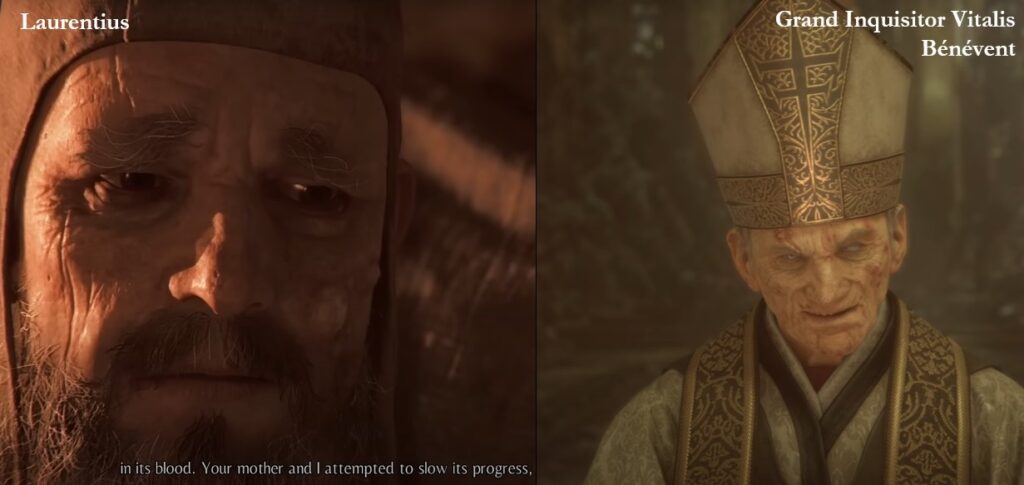Jéssica Iolanda Costa Bispo (Nova University of Lisbon)
A Plague Tale: Innocence is a video game focusing on stealth mechanics that presents the player a narrative taking place in Medieval France. It follows the character Amicia de Rune’s struggles as she flees from her home with her brother Hugo – who is afflicted by an ancient curse (the Prima Macula) –, as they are persecuted by the Inquisition (which intends to acquire the Macula so as to gain power) and hordes of black rats that behave strangely and spread the Black Plague (which Hugo comes to control and use in his favor as a result of the curse). This paper explores how the game’s narrative operates through multiple dualities and binary dynamics, with a recurrent conflict between opposites, but also how the character Hugo can break these boundaries and emerge as an ambiguous figure.

Immediately in the beginning of the game, Hugo is presented as being utterly lonely. When approaching her mother’s study and the room where Hugo is kept, Amicia is told: “Close the door (…) He is not contagious. I realise you hardly know him, but he will be alright.” (Asobo Studio), hinting at the boy’s lack of socialisation. When the player controls Amicia after the Inquisition storms the house in search of Hugo, it becomes apparent that he quickly panics when left alone, is reluctant to leave his sister’s side, and is often anxious. As the game progresses, Amicia and Hugo meet several characters, and Hugo progressively becomes more confident, communicative and self-reliant, with the final battle being partially fought by the boy. So, loneliness and a state of innocence and naivety are set in contrast with companionship, experience and knowledge, and Hugo manages to effectively pass from one state to another.

The dichotomy between science and religion is also evident. While Hugo’s mother, her mentor and doctor Laurentius and Laurentius’s apprentice Lucas recurrently try to figure out Hugo’s condition through a scientific lens (and a treatment for it), Grand Inquisitor Vitalis Bénévent tries to capture Hugo in order to use the curse’s powers to install a new world order. Furthermore, the population’s lack of knowledge is evinced by the way they persecute Amicia and Hugo in several parts of the video game, and also contrasts with those willing to understand more about Hugo’s disease and how it differs from the Black Plague.

In another interesting take, the rats Hugo controls are black, and Bénévent’s rats are white. This is a curious binary that subverts expectations, as Hugo is seen as a “good” character and Bénévent as an “evil” one, and white is typically associated with purity and innocence (Chevalier e Gheerbrant 1108), while black is associated with evil and the underworld (Ibidem 93).

Again, Hugo inverts typical dualities that are present in our collective imaginary. And the reason why A Plague Tale: Innocence draws on so many binary dynamics (with many more besides the ones listed presently) may allude to the way the Middle Ages are perceived in our own contemporary times, as it can be (too) easy to give in to the stereotype of the Dark Ages against our own post-Enlightnment, postmodern age. However, in the Middle Ages, innovation and research did not stop: the first universities were created, cities were developed, complex buildings such as gothic cathedrals were erected, and inventions were made in sectors such as metallurgy and agriculture. As the game’s setting and construction may mirror this perspective, Hugo emerges, nonetheless, as an interestingly ambiguous figure, inviting the player to engage with him empathetically and to counter possibly non-critical, bleak and dualistic perspectives about the Middle Ages.
Works Cited
Asobo Studio. A Plague Tale: Innocence. Focus Home Interactive (PC Windows), 2019.
Chevalier, Jean, and Alain Gheerbrant. The Penguin Dictionary of Symbols. Translation by John Buchanan-Brown, Penguin Books, 1997.
The author, Jéssica Iolanda Costa Bispo, wishes to acknowledge the financial support provided by the Portuguese funding institution FCT – Fundação para a Ciência e a Tecnologia, through an awarded PhD Studentship (2021.04811.BD).

Thank you for a really interesting paper, Jessica. I remember playing the game a while ago now and being really fascinated by Hugo’s character. Slightly on the side here, but I wonder if you have any other examples of games portraying medieval childhood, and if so, how do you think the portrayal in Plague Tale ranks among them?
Thank you Markus!
Actually, I don’t remember a lot of games with a medieval setting that contain child characters. TESV: Skyrim comes to mind, but then again, it is set in a fantastical and imagined setting. In Manor Lords, released this year (and that I’m really enjoying at the moment!), there is no children, though I think the developer intends to add them, and I’m really curious to see how.
Even great and recent works on the portrayal of childhood in video games (like Emma Reay’s The Child in Videogames: From the Meek, to the Mighty, to the Monstrous) omit this, presumably because it’s pretty rare and, most of the times, not that accurate. I remember reading about medieval children in Philippe Ariès’s Centuries of Childhood: A Social History of Family Life, and how, in the 10th, 11th and 12th centuries, there was a disregard for the image of the child as it was presented later on (for instance, during Romanticism and the Victorian Era). Due to the high infant mortality rate, there was little opportunity to develop a strong emotional bond with children and they also lacked artistic representation, being commonly shown only as an adult on a small scale. Even if by the 13th century, children appeared more frequently in the visual arts (as a result of the growing influence of Christianity) they still continued to be represented as small adults. Curiously, this lack of representation seems to coincide with the lack of representation of medieval children in video games nowadays, and this sounds like a wonderful topic to be explored later on!
Thanks for this, Jessica. Really interesting. Children definitely seems like something most medieval games treat like an unnecessary nuisance – but I am glad to hear they might be coming to Manor Lords!
Parabéns pelo paper, Jéssica!
You acknowledged having received a research grant. I assume this means your work with PT:I is tied to a broader research project? If so, could you talk a bit about it?
Obrigada Vinicius!
Actually, my work with PT:I is not related to my PhD project, which is funded by a research grant. I’m conducting research on Neo-victorian video game adaptations of Lewis Carroll’s Alice in Wonderland books! Although that is my main research interest and focus at the moment, I always try to expand my knowledge on other games and from the most diverse theoretical frameworks and points of view. That is how this piece came to be. Just me exploring other themes and other games!
Do you think there’s an extent to which the subverted dynamics of e.g. conventional black/white are part of a wider societal trend towards “reverse dynamic” aesthetics and more marginalised protagonists? Thinking of e.g. Divinity: Original Sin 2 where the magisters and the Divine similarly are bad guys with very purity-religious aesthetics, or the success of the Assassins’ Creed franchise where all the protagonists are very much in the shady/stabby line and the Templars are in a sense more traditional protectors of order who might be expected to be more positively portrayed in more traditional media.
Thank you for your comment!
I do think that we might draw a parallel between the representation of the black and white colours as they appear in PT:I, and the trend that you are referring. This reminds me that, in many video games with a Gothic aesthetic, where black is predominant (along with red, for instance), this is represented as a powerful colour in the sense that is associated with things that give power to a marginalised character seeking for representation and empowerment (American McGee’s Alice, Alice: Madness Returns, and Fran Bow come to mind). So, colours that are typically associated with Evil, the underworld or the underground (as I mentioned in my paper), are subverted in the sense that their accepted and culturally imagined meaning is redefined, which indeed, I think, is a very interesting trend nowadays (and not just in the video game industry).
Thanks for your article. Is there a study that caught your attention regarding the preference in the use of White and Black?
Thank you for your question! I actually struggled to find a study on the colours used in PT:I. I was hoping someone could shed some light on pertinent references on this topic! I couldn’t find any…
I do think I’ve read something about this in a previous MAMG conference, but my memory must be deceiving me, as I consulted every conference proceedings and wasn’t able to find what I was looking for (maybe I overlooked it!).
[…] •18:00: Binary Dynamics in A Plague Tale: Innocence – Jéssica Iolanda Costa Bispo(Nova University of … […]